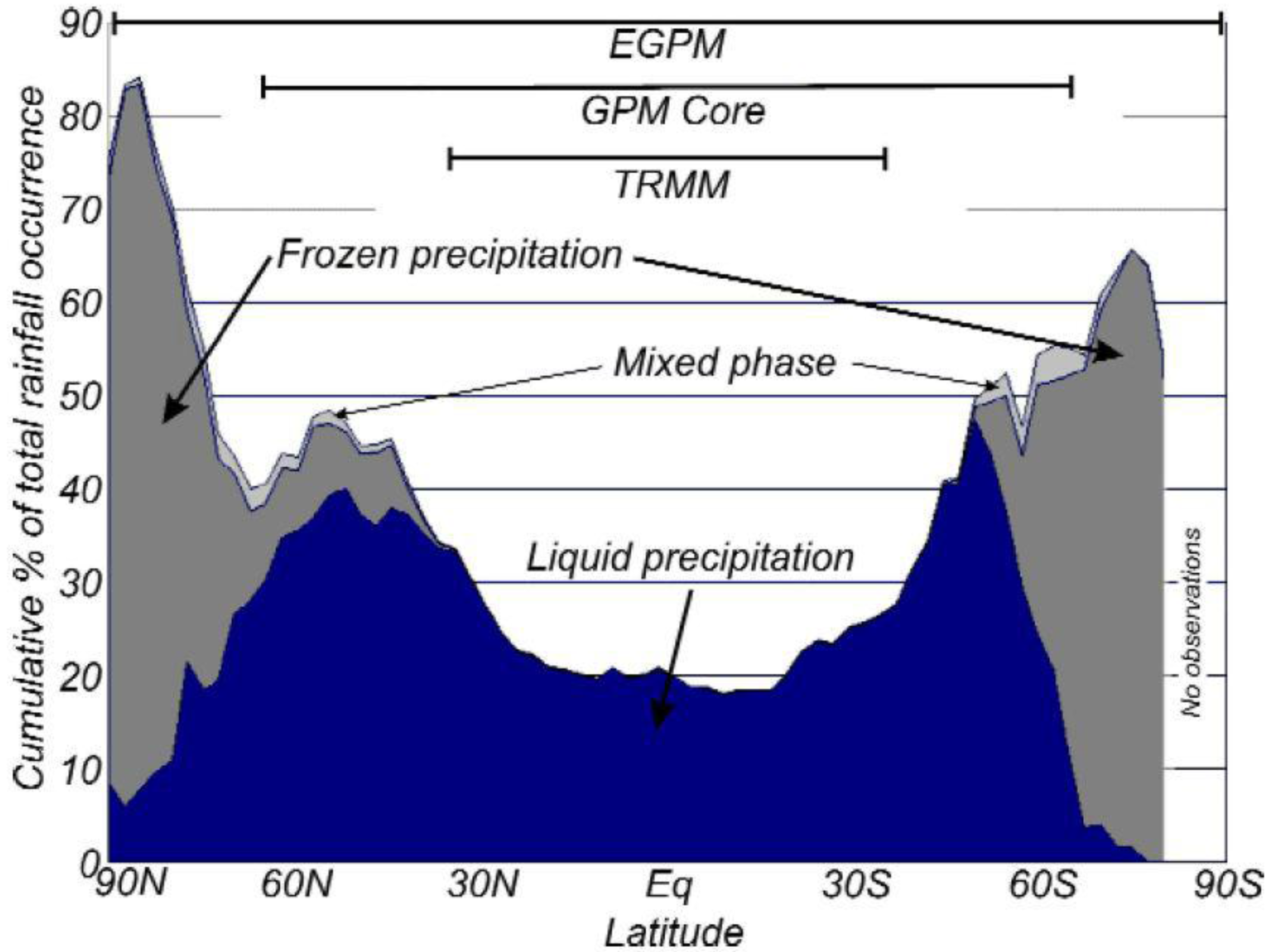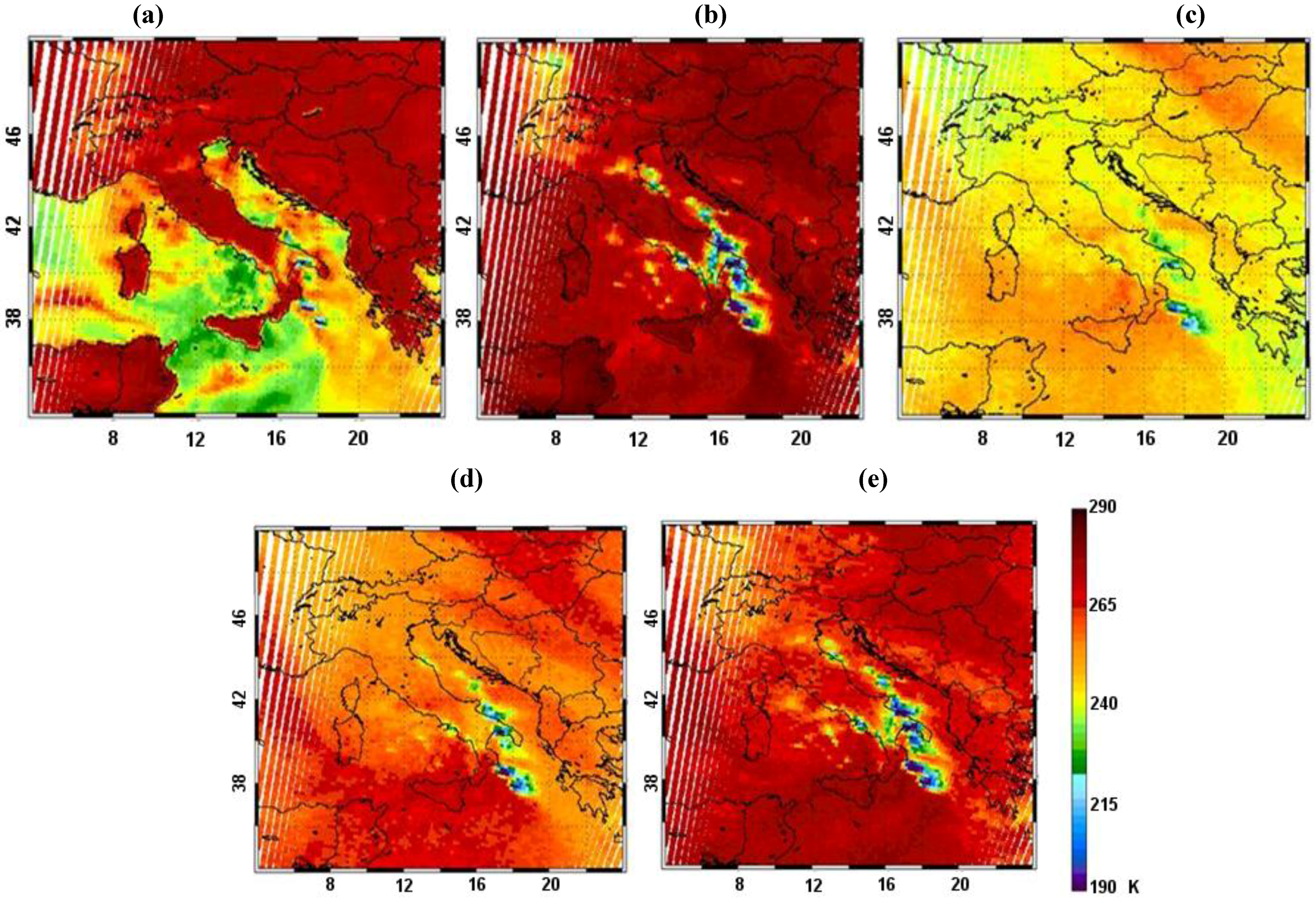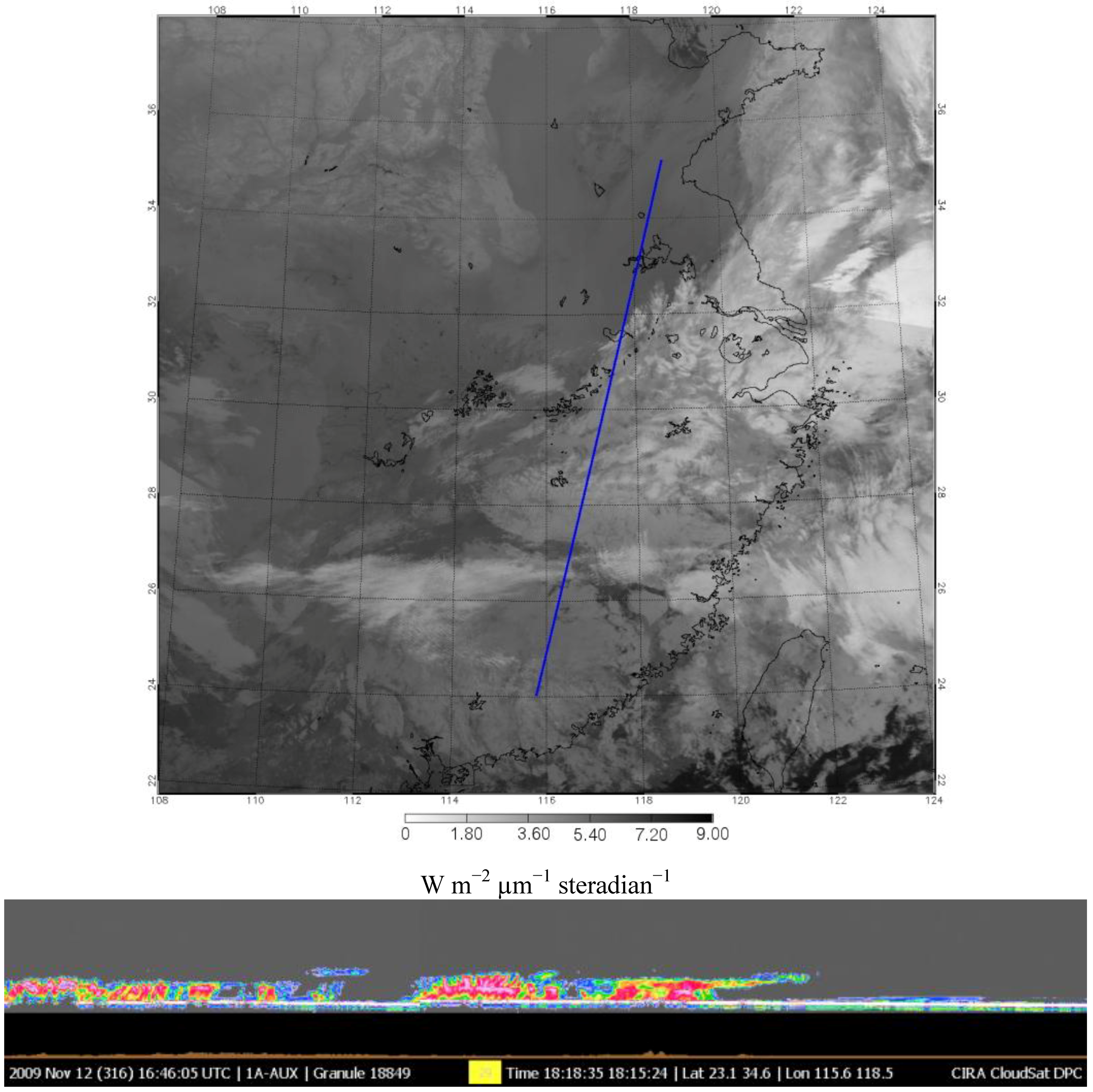Detection and Measurement of Snowfall from Space
Abstract
:1. Introduction

- Ice hydrometeors are scarcely distinguishable from water drops in the visible and infrared spectral channels, while in the PMW the snow signal below 90 GHz is quite weak. This leads to considering frequencies above 100 GHz as candidates for snowfall retrievals. The latter are hosted onboard a limited number of missions that were only launched in recent times.
- The radiative properties of snowflakes and ice crystals are much more complex than those of water droplets due to the inherent non-sphericity of the ice hydrometeors (e.g., [8,9]). Moreover, the thermal emission of water vapor and of water clouds often mask the scattering from snow thus reducing the snowfall signal [10]. The dimensions and aggregation modes of ice crystals in natural clouds [11] are also not completely understood.
- The vertical structure of ice clouds is scarcely known. Ice crystal concentrations are very variable with ice nuclei and environmental conditions (e.g., [12,13,14]) so that it is difficult to decide upon an unambiguous microphysical structure given a set of available PMW observations from space that necessarily refer to the whole atmospheric column.
- Last but certainly not least is the problem of the understanding of snow microphysics in mixed clouds. The presence of super cooled water poses problems when trying to untangle the radiative contributions of water and ice for snowfall detection from the ground and from space. First the microphysics of super cooled water is not completely understood (e.g., temperature range), and second, the uncertainties in the absorption of super cooled water are difficult to pinpoint due to the lack of laboratory measurements at frequencies above 10 GHz. Laboratory experiments and ground-based radiometer measurements were recently carried out for checking the ability of common dielectric models of liquid water for the simulation of microwave absorption of super cooled clouds [15], and for the improvement of the physical assumptions behind snowfall retrieval methods and numerical model parameterizations (e.g., [16]).
2. Ice Cloud Structure and Response in the Microwaves
2.1. Ice Cloud Structure from Recent Field Studies
2.2. Ice Cloud Sensing in the Microwaves

3. Snowfall Retrieval Methods from Space
3.1. Passive Microwave Methods



3.2. Radar Methods

4. Future Research
Acknowledgements
References and Notes
- Worley, S.J.; Woodruf, S.D.; Reynolds, R.W.; Lubker, S.J.; Lott, N. ICOADS Release 2.1 data and products. Int. J. Climatol. 2005, 25, 823–842. [Google Scholar] [CrossRef]
- Doesken, N.J.; Judson, A. The Snow Booklet: A Guide to the Science, Climatology and Measurements of Snow in the United States, 2nd ed.; Colorado State University: Fort Collins, CO, USA, 1996; p. 85. [Google Scholar]
- ESA. EGPM—European Contribution to Global Precipitation Measurement; ESA SP-1279(5); ESA: Noordwijk, The Netherlands, 2004; p. 60. [Google Scholar]
- Kidd, C.; Levizzani, V.; Bauer, P. A review of satellite meteorology and climatology at the start of the twenty-first century. Progr. Phys. Geog. 2009, 33, 474–489. [Google Scholar] [CrossRef]
- Kidd, C.; Levizzani, V.; Turk, F.J.; Ferraro, R.R. Satellite precipitation measurements for water resource monitoring. J. Amer. Water Resour. Assoc. 2009, 45, 567–579. [Google Scholar] [CrossRef]
- Levizzani, V.; Bauer, P.; Turk, F.J. Measuring Precipitation from Space: EURAINSAT and the Future; Springer: Dordrecht, The Netherlands, 2007; p. 722. [Google Scholar]
- Michaelides, S.; Levizzani, V.; Anagnostou, E.N.; Bauer, P.; Kasparis, T.; Lane, J.E. Precipitation: Measurement, remote sensing, climatology and modeling. Atmos. Res. 2009, 94, 512–533. [Google Scholar] [CrossRef]
- Justo, J.E.; Weickmann, K.K. Types of snowfall. Bull. Amer. Meteor. Soc. 1973, 54, 1148–1162. [Google Scholar] [CrossRef]
- Magono, C.; Lee, C.W. Meteorological classification of natural ice crystals. J. Faculty Sci. Hokkaido Univ. Ser. VII 1966, 2, 321–335. [Google Scholar]
- Liu, G.; Curry, J.A. An investigation of the relationship between emission and scattering signals in SSM/I data. J. Atmos. Sci. 1998, 55, 1628–1643. [Google Scholar] [CrossRef]
- Hobbs, P.V.; Chang, S.; Locatelli, J.D. The dimensions and aggregation of ice crystals in natural clouds. J. Geophys. Res. 1974, 79, 2199–2206. [Google Scholar] [CrossRef]
- Gunn, K.L.S.; Marshall, J.S. The distribution with size of aggregate snowflakes. J. Meteorol. 1958, 15, 452–461. [Google Scholar] [CrossRef]
- Auer, A.H.; Veal, D.L.; Marwitz, J.D. Observations of ice crystal and ice nuclei concentrations in stable cap clouds. J. Atmos. Sci. 1969, 26, 1342–1343. [Google Scholar] [CrossRef]
- Mossop, S.C. Concentrations of ice crystals in clouds. Bull. Amer. Meteor. Soc. 1970, 51, 474–479. [Google Scholar] [CrossRef]
- Mätzler, C.; Rosenkranz, P.W.; Cermak, J. Microwave absorption of supercooled clouds and implications for the dielectric properties of water. J. Geophys. Res. 2010, 115, D23208. [Google Scholar] [CrossRef]
- Kneifel, S.; Löhnert, U.; Battaglia, A.; Crewell, S.; Siebler, D. Snow scattering signals in ground-based passive microwave radiometer measurements. J. Geophys. Res. 2010, 115, D16214. [Google Scholar] [CrossRef]
- Field, P.R.; Wood, R.; Brown, P.R.A.; Kaye, P.H.; Hirst, E.; Greenaway, R.; Smith, J.A. Ice particle interarrival times measured with a fast FSSP. J. Atmos. Oceanic Technol. 2003, 20, 249–261. [Google Scholar] [CrossRef]
- Field, P.R.; Heymsfield, A.J.; Bansemer, A. Shattering and particle interarrival times measured by optical array probes in ice clouds. J. Atmos. Oceanic Technol. 2006, 23, 1357–1371. [Google Scholar] [CrossRef]
- Heymsfield, A.J.; Field, P.; Bansemer, A. Exponential size distributions for snow. J. Atmos. Sci. 2008, 65, 4017–4031. [Google Scholar] [CrossRef]
- Korolev, A.V.; Isaac, G.A.; Mazin, I.P.; Barker, H.W. Microphysical properties of continental clouds from in situ measurements. Quart. J. Roy. Meteor. Soc. 2001, 127, 2117–2151. [Google Scholar] [CrossRef]
- Gultepe, I.; Isaac, G.A.; Cober, S.G. Ice crystals number concentration versus temperature for climate studies. Int. J. Climatol. 2001, 21, 1281–1302. [Google Scholar] [CrossRef]
- Korolev, A.V.; Isaac, G.A.; Cober, S.G.; Strapp, J.W.; Hallett, J. Microphysical characterization of mixed-phase clouds. Quart. J. Roy. Meteor. Soc. 2003, 129, 39–65. [Google Scholar] [CrossRef]
- Wilheit, T.T.; Chang, A.T.C.; King, J.L.; Rodgers, E.B.; Nieman, R.A.; Krupp, B.M.; Milman, A.S.; Stratigos, J.S.; Siddalingaiah, H. Microwave radiometric observations near 19.35, 92 and 183 GHz of precipitation in Tropical Storm Cora. J. Appl. Meteor. 1982, 21, 1137–1145. [Google Scholar] [CrossRef]
- Bennartz, R.; Petty, G.W. The sensitivity of microwave remote sensing observations of precipitation to ice particle size distributions. J. Appl. Meteor. 2001, 40, 345–364. [Google Scholar] [CrossRef]
- Evans, K.F.; Stephens, G.L. Microwave radiative transfer through clouds composed of realistically shaped ice crystals. Part I: Single scattering properties. J. Atmos. Sci. 1995, 52, 2041–2057. [Google Scholar] [CrossRef]
- Evans, K.F.; Stephens, G.L. Microwave radiative transfer through clouds composed of realistically shaped ice crystals. Part II: Remote sensing of ice clouds. J. Atmos. Sci. 1995, 52, 2058–2072. [Google Scholar] [CrossRef]
- Liu, G. Approximation of single scattering properties of ice and snow particles for high microwave frequencies. J. Atmos. Sci. 2004, 61, 2441–2456. [Google Scholar] [CrossRef]
- Doherty, A.M.; Sreerekha, T.R.; O’Keeffe, U.M.; English, S.J. Ice hydrometeor microphysical assumptions in radiative transfer models at AMSU-B frequencies. Quart. J. Roy. Meteor. Soc. 2007, 133, 1205–1212. [Google Scholar] [CrossRef]
- Bennartz, R.; Bauer, P. Sensitivity of microwave radiances at 85–183 GHz to precipitating ice particles. Radio Sci. 2003, 38, 8075. [Google Scholar] [CrossRef]
- Hong, G.; Heygster, G.; Miao, J.; Kunzi, K. Sensitivity of microwave brightness temperatures to hydrometeors in a tropical deep convective cloud system at 89–190 GHz. Radio Sci. 2005, 40, RS4003. [Google Scholar] [CrossRef]
- Weng, F.; Grody, N.C. Retrieval of ice cloud parameters using a microwave imaging radiometer. J. Atmos. Sci. 2000, 57, 1069–1081. [Google Scholar] [CrossRef]
- Saunders, R.W.; Hewison, T.J.; Stringer, S.J.; Atkinson, N.C. The radiometric characterization of AMSU-B. IEEE Trans. Microw. Theory Tech. 1995, 43, 760–771. [Google Scholar] [CrossRef]
- Kakar, R.K. Retrieval of clear sky moisture profiles using the 183 GHz water vapor line. J. Clim. Appl. Meteorol. 1983, 22, 1282–1289. [Google Scholar] [CrossRef]
- Wilheit, T.T. An algorithm for retrieving water vapor profiles in clear and cloudy atmospheres from 183 GHz radiometric measurements: Simulation studies. J. Appl. Meteor. 1990, 29, 508–515. [Google Scholar] [CrossRef]
- Muller, B.M.; Fuelberg, H.E.; Xiang, X. Simulations of the effects of water vapor, cloud liquid water, and ice on AMSU moisture channel brightness temperatures. J. Appl. Meteor. 1994, 33, 1133–1154. [Google Scholar] [CrossRef]
- Greenwald, T.J.; Christopher, S.A. Effect of cold clouds on satellite measurements near 183 GHz. J. Geophys. Res. 2002, 107, D134170. [Google Scholar] [CrossRef]
- Karbou, F.; Aires, F.; Prigent, C.; Eymard, L. Potential of Advanced Microwave Sounding Unit-A (AMSU-A) and AMSU-B measurements for atmospheric temperature and humidity profiling over land. IEEE Trans. Geosci. Remote Sens. 2005, 110, D07109. [Google Scholar] [CrossRef]
- Bauer, P.; Grody, N.C. The potential of combining SSM/I and SSM/T2 measurements to improve the identification of snowcover and precipitation. IEEE Geosci. Remote Sens. Lett. 1995, 33, 252–261. [Google Scholar] [CrossRef]
- Wang, J.R.; Racette, P.E.; Triesky, M.E. Retrieval of precipitable water vapor by the millimeter-wave imaging radiometer in the Arctic region during FIRE-ACE. IEEE Geosci. Remote Sens. Lett. 2001, 39, 595–605. [Google Scholar] [CrossRef]
- Weng, F.; Yan, B.; Grody, N.C. A microwave land emissivity model. J. Geophys. Res. 2001, 106, 20115–20123. [Google Scholar] [CrossRef]
- Prigent, C.; Chevallier, F.; Karbou, F.; Bauer, P.; Kelly, G. AMSU-A land surface emissivity estimation for numerical weather prediction assimilation schemes. J. Appl. Meteor. 2005, 44, 416–426. [Google Scholar] [CrossRef]
- Liu, G.; Curry, J.A. Precipitation characteristics in Greenland-Iceland-Norwegian Seas determined by using satellite microwave data. J. Geophys. Res. 1997, 102, 13987–13997. [Google Scholar] [CrossRef]
- Katsumata, M.; Uyeda, H.; Iwanami, K.; Liu, G. The response of 36- and 89-GHz microwave channels to convective snow clouds over ocean: Observation and modeling. J. Appl. Meteor. 2000, 39, 2322–2335. [Google Scholar] [CrossRef]
- Bennartz, R.; Thoss, A.; Dybbroe, A.; Michelson, D. Precipitation analysis using the Advanced Microwave Sounding Unit in support of nowcasting applications. Meteor. Appl. 2002, 9, 177–189. [Google Scholar] [CrossRef]
- Ferraro, R.R.; Weng, F.; Grody, N.C.; Zhao, L. Precipitation characteristics over land from the NOAA-15 AMSU sensor. Geophys. Res. Lett. 2000, 27, 2669–2672. [Google Scholar] [CrossRef]
- Ferraro, R.R.; McCollum, J.R. Rainfall over Land from the AMSR-E. In Proceedings of 2003 IEEE International Geoscience and Remote Sensing Symposium, Toulouse, France, July 21–25, 2003; pp. 669–671.
- Weng, F.; Zhao, L.; Ferraro, R.R.; Poe, G.; Li, X.; Grody, N.C. Advanced microwave sounding unit cloud and precipitation algorithms. Radio Sci. 2003, 38, 8068. [Google Scholar] [CrossRef]
- Grody, N.; Weng, F.; Ferraro, R. Application of AMSU for obtaining hydrological parameters. In Microwave Radiometry Remote Sensing of the Earth’s Surface and Atmosphere; Pampaloni, P., Paloscia, S., Eds.; VSP BV: Zeist, The Netherlands, 2000; pp. 339–352. [Google Scholar]
- Ferraro, R.R.; Weng, F.; Grody, N.C.; Zhao, L.; Meng, H.; Kongoli, C.; Pellegrino, P.; Qiu, S.; Dean, C. NOAA operational hydrological products derived from the Advanced Microwave Sounding Unit. IEEE Trans. Geosci. Remote Sens. 2005, 43, 1036–1049. [Google Scholar] [CrossRef]
- Kongoli, C.; Pellegrino, P.; Ferraro, R.R.; Grody, N.C.; Meng, H. A new snowfall detection algorithm over land using measurements from the Advanced Microwave Sounding Unit (AMSU). Geophys. Res. Lett. 2003, 30. [Google Scholar] [CrossRef]
- Meng, H.; Ferraro, R.R.; Yan, B. Snowfall rate retrieval using AMSU/MHS passive microwave data. In Proceedings of Joint 2007 EUMETSAT Meteorological Satellite Conference and the 15th Satellite Meteorology & Oceanography Conference of the American Meteorological Society, Amsterdam, The Netherlands, September 24–28, 2007; Available online: http://www.eumetsat.int/Home/Main/Publications/Conference_and_Workshop_Proceedings/groups/cps/documents/document/pdf_conf_p50_s10_13_meng_p.pdf (accessed on 10 January 2011).
- Skofronick-Jackson, G.M.; Weinman, J.A.; Chang, D.-E. Observation of snowfall over land by microwave radiometry from space. In Proceedings of 2002 IEEE International Geoscience and Remote Sensing Symposium, Toronto, ON, Canada, June 24–28, 2002; pp. 1866–1868.
- Skofronick-Jackson, G.M.; Kim, M.-J.; Weinman, J.A.; Chang, D.-E. A physical model to determine snowfall over land by microwave radiometry. IEEE Trans. Geosci. Remote Sens. 2004, 42, 1047–1058. [Google Scholar] [CrossRef]
- Kim, M.-J.; Weinman, J.A.; Olson, W.S.; Chang, D.-E.; Skofronick-Jackson, G.; Wang, J.R. A physical model to estimate snowfall over land using AMSU-B observations. J. Geophys. Res. 2008, 113, D09201. [Google Scholar] [CrossRef]
- D’Aurizio, S. Sviluppo di un algoritmo per la stima delal precipitazione nevosa nelle microonde ad alta frequenza da satellite. M.Sc. Thesis, Department of Physics, University of Bologna, Bologna, Italy, 2010; p. 71. [Google Scholar]
- Laviola, S.; Levizzani, V. Rain retrieval using the 183 GHz absorption lines. In Proceedings of 2008 Microwave Radiometry and Remote Sensing of the Environment, Firenze, Italy, March 11–14, 2008. [CrossRef]
- Laviola, S.; Levizzani, V. Observing precipitation by means of water vapor absorption lines: A first check of the retrieval capabilities of the 183-WSL rain retrieval method. Italian J. Remote Sens. 2009, 41, 39–49. [Google Scholar] [CrossRef]
- Laviola, S.; Levizzani, V. The 183-WSL fast rain rate retrieval algorithm. Part I: Retrieval design. Atmos. Res. 2011. [Google Scholar] [CrossRef]
- Noh, Y.-J.; Liu, G.; Jones, A.S.; Haar, T.H.V. Toward snowfall retrieval over land by combining satellite and in situ measurements. J. Geophys. Res. 2009, 114, D24205. [Google Scholar] [CrossRef]
- Stephens, G.L.; Vane, D.G.; Boain, R.J.; Mace, G.G.; Sassen, K.; Wang, Z.; Illingworth, A.J.; O’Connor, E.J.; Rossow, W.B.; Durden, S.L.; Miller, S.D.; Austin, R.T.; Benedetti, A.; Mitrescu, C.; The CloudSat Science Team. The CloudSat mission and the A-Train: A new dimension of space-based observations of clouds and precipitation. Bull. Amer. Meteor. Soc. 2002, 83, 1771–1790. [Google Scholar] [CrossRef]
- Liu, G. Deriving snow cloud characteristics from CloudSat observations. J. Geophys. Res. 2008, 113, D00A09. [Google Scholar] [CrossRef]
- Matrosov, S.Y. Modeling backscatter properties of snowfall at millimeter wavelengths. J. Atmos. Sci. 2007, 64, 1727–1736. [Google Scholar] [CrossRef]
- Austin, R.T.; Heymsfield, A.J.; Stephens, G.L. Retrieval of ice cloud microphysical parameters using the CloudSat millimeter-wave radar and temperature. J. Geophys. Res. 2009, 114, D00A23. [Google Scholar] [CrossRef]
- Austin, R.T.; Stephens, G.L. Retrieval of stratus cloud microphysical parameters using millimeter-wave radar and visible optical depth in preparation for CloudSat. 1. Algorithm formulation. J. Geophys. Res. 2001, 106, 28233–28242. [Google Scholar] [CrossRef]
- Benedetti, A.; Stephens, G.L.; Haynes, J.M. Ice cloud microphysics retrievals from millimeter radar and visible optical depth using an estimation theory approach. J. Geophys. Res. 2003, 108. D11, 4335. [Google Scholar] [CrossRef]
- Johnson, B.T.; Skofronick-Jackson, G.M.; Petty, G.W. Combined passive and active microwave retrieval of falling snow during the 2003 Wakasa Bay field experiment. In Proceedings of 2008 Microwave Radiometry and Remote Sensing of the Environment, Firenze, Italy, March 11–14, 2008. [CrossRef]
- Grecu, M.; Olson, W.S. Precipitating snow retrievals from combined airborne cloud radar and millimeter-wave radiometer observations. J. Appl. Meteor. Climatol. 2008, 47, 1634–1650. [Google Scholar] [CrossRef]
- Draine, B.T.; Flatau, P.J. Discrete-dipole approximation for scattering calculations. J. Opt. Soc. Am. A 1994, 11, 1491–1499. [Google Scholar] [CrossRef]
- Xu, Y.-L.; Gustafson, B.A.S. A generalized multiparticle Mie-solution: Further experimental verification. J. Quant. Spectrosc. Radiat. Transf. 2001, 70, 395–419. [Google Scholar] [CrossRef]
- Battaglia, A.; Ajewole, M.O.; Simmer, C. Evaluation of radar multiple scattering effects in Cloudsat configuration. Atmos. Chem. Phys. 2007, 7, 1719–1730. [Google Scholar] [CrossRef]
- Matrosov, S.Y.; Battaglia, A. Influence of multiple scattering on CloudSat measurements in snow: A model study. Geophys. Res. Lett. 2009, 36, L12806. [Google Scholar] [CrossRef]
- Kulie, M.S.; Bennartz, R. Utilizing spaceborne radars to retrieve dry snowfall. J. Appl. Meteor. Climatol. 2009, 48, 2564–2580. [Google Scholar] [CrossRef]
- Hudak, D.; Rodriguez, P.; Donaldson, N. Validation of the CloudSat precipitation occurrence algorithm using the Canadian C band radar network. J. Geophys. Res. 2008, 113, D00A07. [Google Scholar] [CrossRef]
- Turk, F.J.; Park, K.; Haddad, Z.; Rodriguez, P.; Hudak, D. Analysis of CloudSat-Based Snowfall Profiles Using C-band Ground Radar. In Proceedings of 5th International Precipitation Working Group Workshop, Hamburg, Germany, October 11–15, 2010.
- Wang, N.-Y.; Ferraro, R.; Gopalan, K. Improvement of Cold Season Precipitation Retrievals through the Use of Field Campaign Data and High Frequency Microwave Radiative Transfer Model. In Proceedings of 4th International precipitation Working Group Workshop, Beijing, China, October 13–17, 2008; pp. 348–353.
- Wang, N.-Y.; Gopolan, K.; Ferraro, R. Developing winter precipitation algorithm over land from satellite microwave and C3VP field campaign observations. In Proceedings of 5th International Precipitation Working Group Workshop, Hamburg, Germany, October 11–15, 2010.
- Todini, G.; Rizzi, R.; Todini, E. Detecting precipitating clouds over snow and ice using a multiple sensors approach. J. Appl. Meteor. Climatol. 2009, 48, 1858–1867. [Google Scholar] [CrossRef]
- King, M.D.; Kaufman, Y.J.; Menzel, W.P.; Tanré, D. Remote sensing of cloud, aerosol, and water vapor properties from the Moderate Resolution Imaging Spectrometer (MODIS). IEEE Trans. Geosci. Remote Sens. 1992, 30, 2–27. [Google Scholar] [CrossRef]
- Staelin, D.H.; Chen, F.W. Precipitation observations near 54 and 183 GHz using the NOAA-15 satellite. IEEE Trans. Geosci. Remote Sens. 2000, 38, 2322–2332. [Google Scholar] [CrossRef]
- Staelin, D.H.; Surussavadee, C. Precipitation retrieval accuracies for geo-microwave sounders. IEEE Trans. Geosci. Remote Sens. 2007, 45, 3150–3159. [Google Scholar] [CrossRef]
- Surussavadee, C.; Staelin, D.H. Comparison of AMSU millimeter-wave satellite observations, MM5/TBSCAT predicted radiances, and electromagnetic models for hydrometeors. IEEE Trans. Geosci. Remote Sens. 2006, 44, 2667–2678. [Google Scholar] [CrossRef]
- Surussavadee, C.; Staelin, D.H. Millimeter-wave precipitation retrievals and observed-versus-simulated radiance distributions: Sensitivity to assumptions. J. Atmos. Sci. 2007, 64, 3808–3826. [Google Scholar] [CrossRef]
- Marzano, F.S.; Cimini, D.; Memmo, A.; Montopoli, M.; Rossi, T.; Sanctis, M.D.; Lucente, M.; Mortari, D.; Michele, S.D. Flower constellation of millimeter-wave radiometers for tropospheric monitoring at pseudogeostationary scale. IEEE Trans. Geosci. Remote Sens. 2009, 47, 3107–3122. [Google Scholar] [CrossRef]
- Brandes, E.A.; Ikeda, K.; Zhang, G.; Schoenhuber, M.; Rasmussen, R.M. A statistical and physical description of hydrometeor distributions in Colorado snowstorms using a video disdrometer. J. Appl. Meteor. Climatol. 2007, 46, 634–650. [Google Scholar] [CrossRef]
- Heymsfield, A.J.; Bansemer, A.; Schmitt, C.; Twohy, C.; Poellot, M.R. Effective ice particle densities derived from aircraft data. J. Atmos. Sci. 2004, 61, 982–1003. [Google Scholar] [CrossRef]
© 2011 by the authors; licensee MDPI, Basel, Switzerland. This article is an open access article distributed under the terms and conditions of the Creative Commons Attribution license (http://creativecommons.org/licenses/by/3.0/).
Share and Cite
Levizzani, V.; Laviola, S.; Cattani, E. Detection and Measurement of Snowfall from Space. Remote Sens. 2011, 3, 145-166. https://0-doi-org.brum.beds.ac.uk/10.3390/rs3010145
Levizzani V, Laviola S, Cattani E. Detection and Measurement of Snowfall from Space. Remote Sensing. 2011; 3(1):145-166. https://0-doi-org.brum.beds.ac.uk/10.3390/rs3010145
Chicago/Turabian StyleLevizzani, Vincenzo, Sante Laviola, and Elsa Cattani. 2011. "Detection and Measurement of Snowfall from Space" Remote Sensing 3, no. 1: 145-166. https://0-doi-org.brum.beds.ac.uk/10.3390/rs3010145






